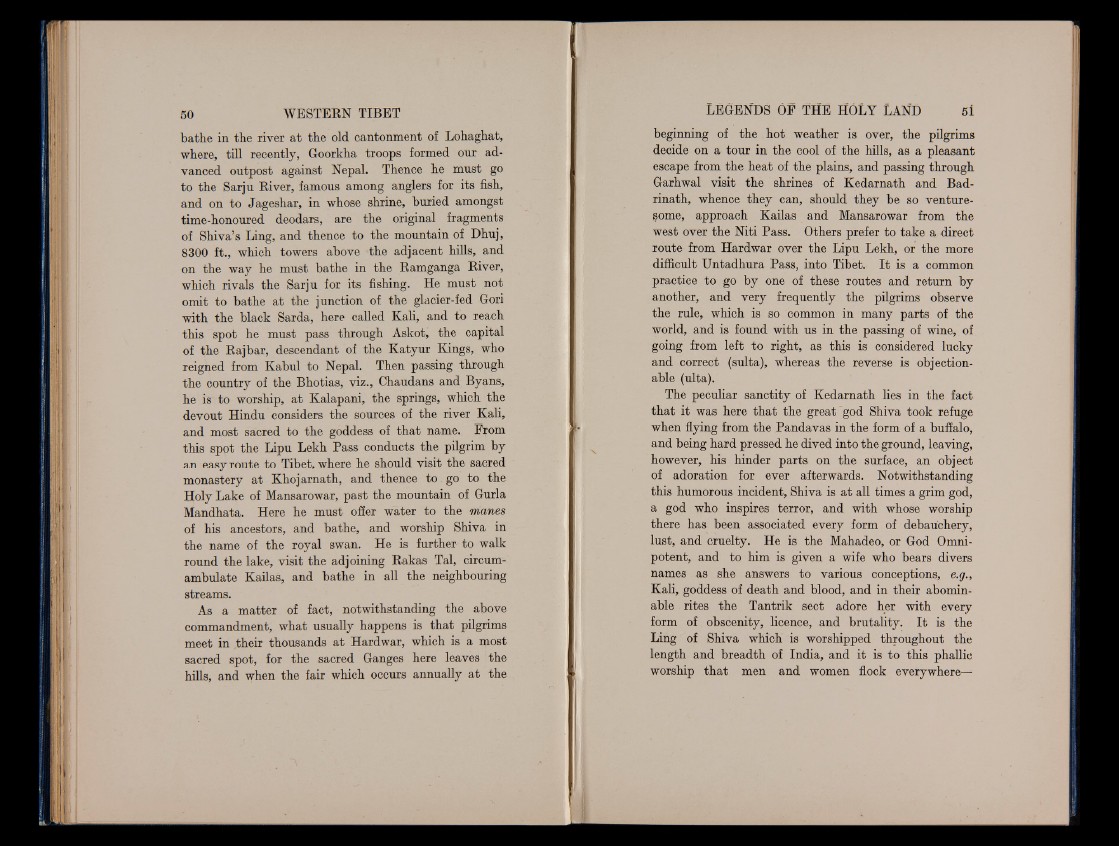
bathe in the river at the old cantonment of Lohaghat,
where, till recently, Goorkha troops formed our advanced
outpost against Nepal. Thence he must go
to the Sarju River, famous among anglers for its fish,
and on to Jageshar, in whose shrine, buried amongst
time-honoured deodars, are the original fragments
of Shiva’s Ling, and thence to the mountain of Dhuj,
8300 ft., which towers above the adjacent hills, and
on the way he must bathe in the Ramganga River,
which rivals the Sarju for its fishing. He must not
omit to bathe at the junction of the glacier-fed Gori
with the black Sarda, here called Kali, and to reach
this spot he must pass through Askot, the capital
of the Raj bar, descendant of the Katyur Kings, who
reigned from Kabul to Nepal. Then passing through
the country of the Bhotias, viz., Chaudans and Byans,
he is to worship, at Kalapani, the springs, which the
devout Hindu considers the sources of the river Kali,
and most sacred to the goddess of that name. From
this spot the Lipu Lekh Pass conducts the pilgrim by
an easy route to Tibet, where he should visit the sacred
monastery at Khojarnath, and thence to go to the
Holy Lake of Mansarowar, past the mountain of Gurla
Mandhata. Here he must offer water to the manes
of his ancestors, and bathe, and worship Shiva in
the name of the royal swan. He is further to walk
round the lake, visit the adjoining Rakas Tal, circumambulate
Kailas, and bathe in all the neighbouring
streams.
As a matter of fact, notwithstanding the above
commandment, what usually happens is that pilgrims
meet in their thousands at Hardwar, which is a most
sacred spot, for the sacred Ganges here leaves the
hills, and when the fair which occurs annually at the
beginning of the hot weather is over, the pilgrims
decide on a tour in the cool of the hills, as a pleasant
escape from the heat of the plains, and passing through
Garhwal visit the shrines of Kedarnath and Bad-
rinath, whence they can, should they be so venturesome,
approach Kailas and Mansarowar from the
west over the Niti Pass. Others prefer to take a direct
route from Hardwar over the Lipu Lekh, or the more
difficult Untadhura Pass, into Tibet. I t is a common
practice to go by one of these routes and return by
another, and very frequently the pilgrims observe
the rule, which is so common in many parts of the
world, and is found with us in the passing of wine, of
going from left to right, as this is considered lucky
and correct (sulta), whereas the reverse is objectionable
(ulta).
The peculiar sanctity of Kedarnath lies in the fact
that it was here that the great god Shiva took refuge
when flying from the Pandavas in the form of a buffalo,
and being hard pressed he dived into the ground, leaving,
however, his hinder parts on the surface, an object
of adoration for ever afterwards. Notwithstanding
this humorous incident, Shiva is at all times a grim god,
a god who inspires terror, and with whose worship
there has been associated every form of debauchery,
lust, and cruelty. He is the Mahadeo, or God Omnipotent,
and to him is given a wife who bears divers
names as she answers to various conceptions, e.g.,
Kali, goddess of death and blood, and in their abominable
rites the Tantrik sect adore her with every
form of obscenity, licence, and brutality. I t is the
Ling of Shiva which is worshipped throughout the
length and breadth of India, and it is to this phallic
worship that men and women flock everywhere—